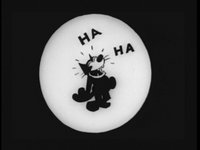 A scene of Felix "laffing" from "Felix in Hollywood" (1923).
A scene of Felix "laffing" from "Felix in Hollywood" (1923).
|
From Wikipedia the free encyclopedia, by MultiMedia |
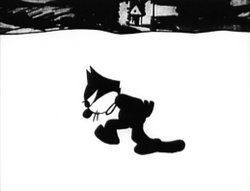 The famous Felix pace as seen in "Oceantics" (1930)
The famous Felix pace as seen in "Oceantics" (1930)
Felix the Cat is a cartoon character from the silent-film era. His black body, white eyes, and giant grin, coupled with the surrealism of the situations in which his cartoons place him, combined to make the Felix one of the most recognizable cartoon characters in the world. Felix was the first character from animation to attain a level of popularity sufficient to draw movie audiences based solely on his star power.
Felix's earliest origins remain disputed. Australian émigré, cartoonist, and film entrepreneur Pat Sullivan and American animator Otto Messmer have both claimed to be his creator, and evidence seems to back up both claims. Many historians, however, including John Canemaker, argue it was Messmer who ghosted for Sullivan. What is certain is that the cat emerged from Sullivan's studio, and cartoons featuring the character enjoyed unprecedented success and popularity in the 1920s. Paramount Pictures distributed the earliest films from 1919 to 1921. Margaret J. Winkler distributed the shorts from 1922 to 1925, the year when Educational Pictures took over the distribution of the shorts. In 1928, Education ceased releasing the Felix cartoons and several were reissued by First National Pictures. Copley Pictures distributed them from 1929 to 1930. He saw a brief three cartoon resurrection in 1936 by the Van Beuren Studios, but the glory of the old days had disappeared during the cat's short-lived stint in color and sound. Sullivan did most of the marketing for the character in the 1920s.
Felix exploded into American popular culture and enjoyed great success overseas as well. He got his own comic strip (drawn by Messmer), and his image soon adorned all sorts of merchandise. Jazz singers such as Paul Whiteman sang about him, and Felix even became the first image ever broadcast by any television transmitter. Nevertheless, the success was short-lived. The arrival of talking cartoons, particularly those of Walt Disney's Mickey Mouse, eclipsed the silent offerings of Sullivan and Messmer. A few talking Felix shorts produced by Sullivan's brother failed to win back audiences.
Television would prove the cat's savior. Felix cartoons began airing on American TV beginning in 1953. Meanwhile, Joe Oriolo, the new artist behind the Felix comic strip, gained the rights to feature Felix in a new series specifically for television. Oriolo introduced new characters, such as Poindexter and Rock Bottom, and he gave Felix a "Magic Bag of Tricks", which could shift into myriad shapes based on Felix's needs. Joe Oriolo's son, Don Oriolo, continues as Felix's caretaker today, and the cat has since starred in other television programs and in a feature film.
 A scene of Felix "laffing" from "Felix in Hollywood" (1923).
A scene of Felix "laffing" from "Felix in Hollywood" (1923).
On November 9, 1919, Master Tom, a character resembling Felix, debuted in a Paramount Pictures short entitled "Feline Follies". Produced by the New York City-based animation studio owned by Pat Sullivan, the cartoon was directed by cartoonist and animator Otto Messmer. It was a success and the Sullivan studio quickly set to work on producing another film featuring Master Tom. This second short was "The Musical Mews" (released November 16, 1919). It too proved to be successful with audiences. Paramount producer John King suggested that the cat ought to be renamed to "Felix", after the Latin words felis (cat) and felix (luck). So, by the third film, "The Adventures of Felix" (released on December 14, 1919), the cat had a new name. In 1924, animator Bill Nolan redesigned the fledgling feline, making him both rounder and cuter. Felix's new looks, coupled with Messmer's mastery of character animation, would soon rocket Felix to international fame.
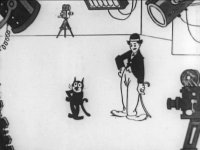 Felix and Charlie Chaplin share the screen in a memorable moment from "Felix
in Hollywood" (1923).
Felix and Charlie Chaplin share the screen in a memorable moment from "Felix
in Hollywood" (1923).
The question of who exactly created Felix remains a matter of dispute. Sullivan stated in numerous newspaper interviews that he created Felix and did the key drawings for the character. On a visit to Australia in 1925, Sullivan told The Argus newspaper: "The idea was given to me by the sight of a cat which my wife brought to the studio one day." [1] Sullivan's statements are supported by his March 18, 1917 release of a cartoon short entitled "The Tail of Thomas Kat", more than two years prior to "Feline Follies". Both an Australian ABC-TV documentary screened in 2004, and an exhibition at the State Library of New South Wales in 2005, suggested that Thomas Kat was a prototype or precursor of Felix. However, few details of Thomas have survived. His fur color has not been definitively established, and the surviving copyright synopsis for the short suggests significant differences between Thomas and the later Felix. Whereas the later Felix magically transforms his tail into tools and other objects, Thomas is a non-anthropomorphized cat who loses his tail in a fight with a rooster, never to recover it.
Sullivan was the studio proprietor and — as is the case with almost all film entrepreneurs — he owned the copyright of any creative work by his employees. In common with many animators at the time, Messmer was not credited. After Sullivan's death in 1933, his estate in Australia took ownership of the character.
It was not until many years after Sullivan's death that Sullivan staffers such as Hal Walker, Al Eugster, and Sullivan's lawyer, Harry Kopp, credited Messmer with Felix's creation. They claimed that Felix was based on an animated Charlie Chaplin that Messmer had animated for Sullivan's studio earlier on. The down-and-out personality and movements of the cat in "Feline Follies" reflect key attributes of Chaplin's and although blockier than the later Felix, the familiar black body is already there (Messmer found solid shapes easier to animate). Messmer himself recalled his version of the cat's creation in an interview with animation historian John Canemaker: "Sullivan's studio was very busy, and Paramount, they were falling behind their schedule and they needed one extra to fill in. And Sullivan, being very busy, said, 'If you want to do it on the side, you can do any little thing to satisfy them.' So I figured a cat would be about the simplest. Make him all black, you know - you wouldn't need to worry about outlines. And one gag after the other, you know? Cute. And they all got laughs. So Paramount liked it so they ordered a series." Aside from Canemaker, the Messmer claim is backed by noteworthy American historians such as Michael Barrier, Jerry Beck, Donald Crafton, David Gerstein, Leonard Maltin, and Charles Solomon.
Regardless of who created Felix, Pat Sullivan marketed the cat relentlessly while the unaccredited Messmer continued to produce a prodigious volume of Felix cartoons. He even began a comic strip in 1923 distributed by King Features Syndicate.
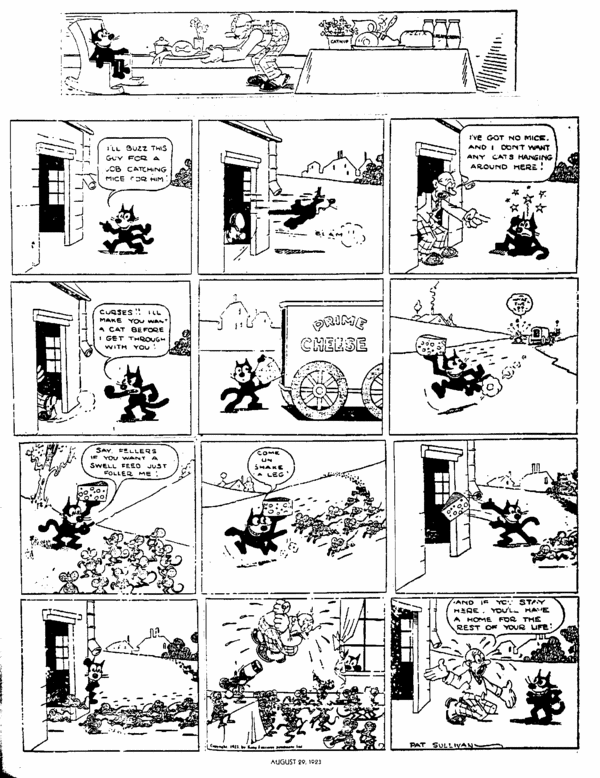 The Felix the Cat comic strip debuted in Britain's Daily Sketch on August
1, 1923 and entered syndication in the US on August 19 that same year. This
particular strip was the second to appear (on August 26). Although this was
Messmer's work, he was required to sign Sullivan's name to it. The strip includes
a notable amount of 1920s slang that seems unusual today, such as "buzz
this guy for a job" and "if you want a swell feed just foller me".
The Felix the Cat comic strip debuted in Britain's Daily Sketch on August
1, 1923 and entered syndication in the US on August 19 that same year. This
particular strip was the second to appear (on August 26). Although this was
Messmer's work, he was required to sign Sullivan's name to it. The strip includes
a notable amount of 1920s slang that seems unusual today, such as "buzz
this guy for a job" and "if you want a swell feed just foller me".
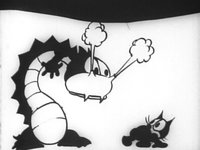 Abstract surrealism was abundant in many of the classic Felix shorts. Shown
here is a still from "Felix Woos Whoopee" (1930).
Abstract surrealism was abundant in many of the classic Felix shorts. Shown
here is a still from "Felix Woos Whoopee" (1930).
When distribution from Paramount expired in 1922, Sullivan began distributing his cartoons through Margaret J. Winkler. Under Winkler, Felix's popularity soared to new heights.
By 1923, the cat was at the peak of his film career. "Felix in Hollywood", a short released during this year, plays upon Felix's popularity, as he becomes acquainted with such fellow celebrities as Douglas Fairbanks, Sr., Cecil B. DeMille, Charlie Chaplin, Ben Turpin, and even censor Will H. Hays. His image could be seen on clocks, Christmas ornaments, and as the first giant balloon ever made for Macy's Thanksgiving Day Parade. Felix also became the subject of several popular songs of the day. Even Paul Whiteman, the king of jazz himself, did a bit on the frisky feline. With the character's success also emerged a handful of new costars. These included Felix's master Willie Brown, a foil named Skiddoo the Mouse, Felix's nephews Inky, Dinky, and Winky, and his girlfriend Kitty.
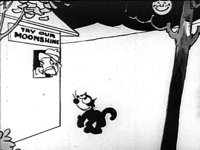 Felix unknowingly requests moonshine from a Prohibition-era bootlegger in "Felix
Finds Out" (1924).
Felix unknowingly requests moonshine from a Prohibition-era bootlegger in "Felix
Finds Out" (1924).
Most of the early Felix cartoons mirrored American attitudes of the time. Ethnic stereotypes appeared in such shorts as "Felix Goes Hungry" (1924). Flappers were caricatured in "Felix Strikes It Rich" (1924). Felix even became involved in union organizing with "Felix Revolts" (1923). References to alcoholism and Prohibition were also commonplace in many of the Felix shorts, particularly "Felix Finds Out" (1924) and "Felix Woos Whoopee" (1930) to name a few. In "Felix Dopes It Out" (1924), Felix tries to help his Hobo friend who is plagued with a red nose. By the end of the short, the cat finds the cure for the sappy schnozzola: "Keep drinking, and it'll turn blue."
In addition, Felix was the first image ever broadcast by television when RCA chose a papier-mâché Felix doll for a 1928 experiment via W2XBS New York in Van Cortlandt Park. The doll was chosen for its tonal contrast and its ability to withstand the intense lights needed. It was placed on a rotating phonograph turntable and photographed for approximately two hours each day. After a one-time payoff to Sullivan, the doll remained on the turntable for nearly a decade as RCA fine-tuned the picture's definition.
Felix's great success also spawned a host of imitators. The appearances and personalities of other 1920s feline stars such as Julius of Walt Disney's Alice Comedies, Waffles of Paul Terry's Aesop's Film Fables, and especially Bill Nolan's 1925 adaptation of Krazy Kat all seemed to have been directly patterned after Felix.
Felix's cartoons were a hit with the critics as well. They have been cited as wonderfully imaginative examples of surrealism in filmmaking. Felix has been said to represent a child's sense of wonder, creating the fantastic when it is not there, and taking it in stride when it is. His famous pace—hands behind his back, head down, deep in thought—became a trademark that was analyzed and re-analyzed by critics around the world. Felix's expressive tail, which could be a shovel one moment, an exclamation mark or pencil the next, serves to emphasize that anything can happen in his world.
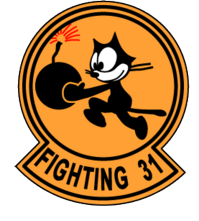 The US Navy insignia for the VF-31 Tomcatters squadron from 1948. The squadron
motto is "We get ours at night"
The US Navy insignia for the VF-31 Tomcatters squadron from 1948. The squadron
motto is "We get ours at night"
Given the character's unprecedented popularity and the fact that his name was partially derived from the Latin word for "happy", some rather notable individuals and organizations adopted Felix as a mascot. The first of these was a Los Angeles Chevrolet dealer and friend of Pat Sullivan named Winslow B. Felix who first opened his showroom in 1921. The three-sided neon sign of Felix Chevrolet, with its giant, smiling images of the character, is today one of LA's best-known landmarks, standing watch over both Figueroa Street and the Harbor Freeway. Others who adopted Felix included the 1922 New York Yankees and aviator Charles Lindbergh, who took a Felix doll with him on his historic flight across the Atlantic Ocean.
This popularity persisted. In the late 1920s, the U.S. Navy's Bombing Squadron Two (VB-2B) adopted a unit insignia consisting of Felix happily carrying a bomb with a burning fuse. They retained the insignia through the 1930s when they became a fighter squadron under the designations VF-6B and, later, VF-3. Early in World War II, a US Navy fighter squadron currently designated VF-31 replaced its winged meat-cleaver logo with the same insignia, after the original Felix squadron had been disbanded. The carrier-based night-fighter squadron, nicknamed the "Tomcatters," remained active under various designations continuing through the present day and Felix still appears on both the squadron's cloth jacket patches and aircraft, still carrying his bomb with its fuse that has yet to burn down.
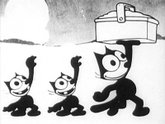 Felix and Inky and Winky in "April Maze" (1930)
Felix and Inky and Winky in "April Maze" (1930)
With the advent of The Jazz Singer in 1927, Educational Pictures, who distributed the Felix shorts at the time, urged Pat Sullivan to make the leap to "talkie" cartoons, but Sullivan refused. Further disputes led to a break between Educational and Sullivan. Only when Walt Disney's Steamboat Willie made cinematic history as the first talking cartoon with a synchronized soundtrack did Sullivan see the possibilities of sound. He managed to secure a contract with First National Pictures in 1928. However, for reasons unknown, this did not last, so Sullivan sought out Jacques Kopfstein and Copley Pictures to distribute his new sound Felix cartoons. On October 16, 1929, an advertisement appeared in Film Daily with Felix announcing, Jolson-like, "You ain't heard nothin' yet!"
Unfortunately, nothing good was heard from Felix's transition to sound. The results were disastrous. More than ever, it seemed as though Disney's mouse was drawing audiences away from Sullivan's silent star. Not even entries such as the off-beat "Felix Woos Whoopee" or the Silly Symphoney-esque "April Maze" (both 1930) could regain the franchise's audience. Kopfstein finally cancelled Sullivan's contract. Subsequently, he announced plans to start a new studio in California, but such ideas never materialized. Things went from bad to worse when Sullivan's wife, Marjorie, died in March 1932. After this, Sullivan completely fell apart. He slumped into an alcoholic depression, his health rapidly declined, and his memory began to fade. He could not even cash checks to Messmer because his signature was reduced to a mere scribble. He died in 1933, leaving his studio in shambles.
In 1935, Amadee J. Van Beuren of the Van Beuren Studios called Messmer and asked him if he could return Felix to the screen. Van Beuren even stated that Messmer would be equipped with a full staff and all of the necessary utilities. However, Messmer declined his offer and instead recommended Burt Gillett, a former Sullivan staffer who was now heading the Van Beuren staff. So, in 1936, Van Beuren obtained approval from Sullivan's brother to license Felix to his studio with the intention of producing new shorts both in color and with sound. With Gillett at the helm, now with a heavy Disney influence, he did away with Felix's established personality and made him just another funny-animal character of the type popular in the day. The new shorts were unsuccessful, and after only three outings Van Beuren discontinued the series.
 Joe Oriolo's Felix
Joe Oriolo's Felix
In 1953, Official Films purchased the Sullivan-Messmer shorts, added soundtracks to them, and distributed to the home movie and television markets. Messmer himself pursued the Sunday Felix comic strips until their discontinuance in 1943, when he began eleven years of writing and drawing monthly Felix comic books for Dell Comics. In 1954, Messmer retired from the Felix daily newspaper strips, and his assistant Joe Oriolo took over. Oriolo struck a deal with Felix's new owner, Pat Sullivan's nephew, to begin a new series of Felix cartoons on television. Oriolo went on to star Felix in 260 television cartoons distributed by Trans-Lux starting in 1958. Like the Van Beuren studio before, Oriolo gave Felix a more domesticated and pedestrian personality, geared more toward children, and introduced now-familiar elements such as Felix's Magic Bag of Tricks, a satchel that could assume the shape and characteristics of anything Felix wanted. The program is also remembered for its distinctive theme song written by Winston Sharples:
The show did away with Felix's previous supporting cast and introduced many new characters. These include the sinister, mustachioed Professor; his intelligent but bookish nephew Poindexter (with an IQ of 222); the Professor's bulldog-faced, bumbling sidekick Rock Bottom; an evil, cylindrical robot and "King of the Moon" named The Master Cylinder; and a small, unassuming and friendly Eskimo named Vavoom, whose only vocalization is a literally earth-shattering shout of his own name. These characters were performed by voice actor Jack Mercer.
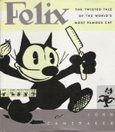 Felix by John Canemaker
Felix by John Canemaker
Oriolo's plots revolve around the unsuccessful attempts of the antagonists to steal Felix's Magic Bag, though in an unusual twist, these antagonists are occasionally depicted as Felix's friends as well. The cartoons proved popular, but critics have dismissed them as paling in comparison to the earlier Sullivan-Messmer works, especially since Oriolo aimed the cartoons at children. Limited animation (required due to budgetary restraints) and simplistic storylines did nothing to diminish the series' popularity.
Today, Oriolo's son, Don continues to market the cat. In 1991, Felix starred in his first (and only) feature film, Felix the Cat: The Movie, in which he, the Professor and Poindexter visit an alternate reality. The film was a box-office failure. In 1995 to 1997, Felix appeared on television again, in an off-beat series called The Twisted Tales of Felix the Cat. Baby Felix followed in 2000 for the Japanese market and the direct-to-video Felix the Cat Saves Christmas. Oriolo has also brought about a new wave of Felix merchandising, everything from mugs to a video game for the Nintendo Entertainment System.
Since the publication of John Canemaker's Felix: The Twisted Tale of the World's Most Famous Cat in 1991, there has been a renewed interest in the early Sullivan-Messmer shorts. In recent years, the films have seen lots of VHS and DVD exposure, most notably on the Presenting Felix the Cat compilations from Bosko Video, Felix! from Lumivision, Felix the Cat: The Collector's Edition from Delta Entertainment, Before Mickey from Inkwell Images Ink, and the recent Felix the Cat and 1920's Rarities from Thunderbean Animation. Messmer Felix comic compilations have also begun to emerge including Nine Lives to Live: A Classic Felix Celebration by David Gerstein and more recently The Comic Adventures of Felix the Cat from Determined Productions.
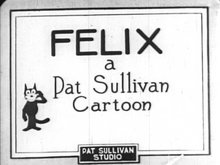 An early Felix title card, 1922.
An early Felix title card, 1922.
Cats, made by MultiMedia | Free content and software
This guide is licensed under the GNU Free Documentation License. It uses material from the Wikipedia.